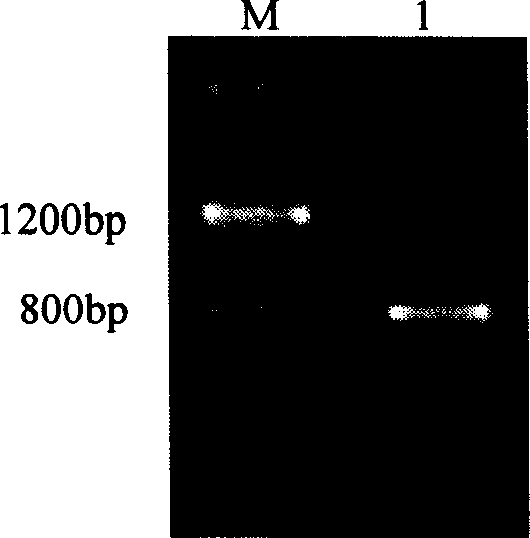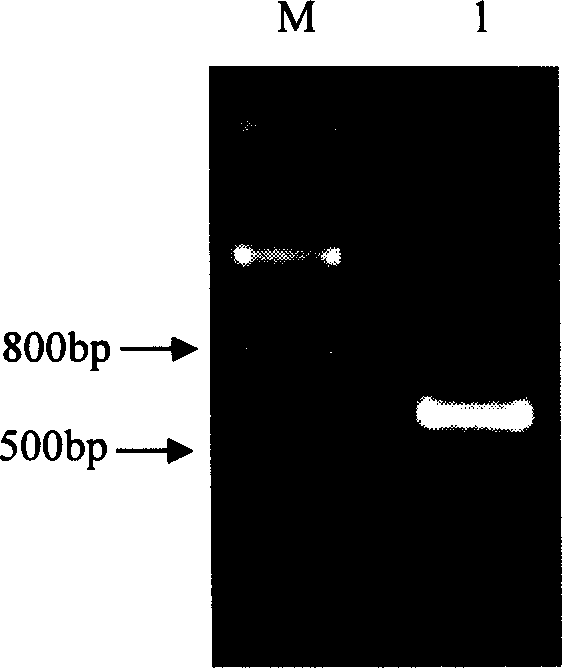Barbadosnut cold-induced transcription factor, its encoding gene and uses
A transcription factor, cold-induced technology, applied in the fields of application, genetic engineering, plant gene improvement, etc., can solve the problems of plant stress resistance, plant stress resistance has not been fully improved, single-function genes, etc., to achieve high practicality The effect of application value, improvement of stress resistance, and broad application prospects
- Summary
- Abstract
- Description
- Claims
- Application Information
AI Technical Summary
Problems solved by technology
Method used
Image
Examples
Embodiment 1
[0043] Embodiment 1, the acquisition of the full sequence of Jatropha curcas cold-induced transcription factor gene JcDREB cDNA
[0044]The acquisition of the full-length cDNA sequence of Jatropha curcas cold-induced transcription factor gene JcDREB comprises the following steps:
[0045] 1. Cloning of Jatropha curcas cold-induced transcription factor gene JcDREB 3' end sequence
[0046] 1. Plant material processing and total RNA extraction
[0047] Firstly, the Jatropha curcas seedlings were used as materials, and the total RNA was extracted after low-temperature treatment at 4°C for 12 hours, and then detected by 1% agarose gel electrophoresis. The electrophoresis bands are 28s RNA and 18s RNA respectively from top to bottom, indicating that the total RNA with higher purity and integrity has been obtained.
[0048] 2. Cloning of Jatropha curcas cold-induced transcription factor gene JcDREB 3' end sequence
[0049] Compare the amino acid residue sequences of the published ...
Embodiment 2
[0065] Example 2, Bioinformatics analysis of JcDREB and its encoded protein
[0066] 1. Sequence analysis of JcDREB gene and prediction of structure and function of its encoded protein
[0067] The full-length cDNA sequence of JcDREB obtained in Example 1 was used for bioinformatics analysis using DNAMAN software, and its structural diagram is shown in Figure 5 (single line indicates 3'-UTR; box indicates open reading frame, containing 2 functional motifs , the black box represents the AP2 domain, and the hatched line on the right represents the acidic activation region), the total length of the sequence is 768bp, from the 1st to the 768th base of the 5' end is ORF, and the encoding consists of 256 amino acid residues Protein, its estimated molecular weight is 31.731kDa, and its isoelectric point pI value is 9.37. Using the SMART tool to predict the function of the deduced amino acid residue sequence, the result is that the protein contains a typical EREBP / AP2 domain, that is...
Embodiment 3
[0072] Embodiment 3, the structural analysis of JcDREB genomic DNA
[0073] Extract the genomic DNA of the cold-treated Jatropha curcas seedlings in Example 1 and use it as a template, and under the guidance of primers JcDREBW-1 and JcDREBW-2, carry out PCR amplification analysis of the structure of the JcDREB gene. After the reaction, the The PCR products were detected by 1% agarose gel electrophoresis, and the detection results are shown in Figure 9 (lane M is the molecular weight standard Marker III, and lane 1 is the PCR amplification product). As a result, a specific band with a length of about 800 bp was amplified by PCR. Using the cDNA of JcDREB as a template, carry out PCR amplification with the above-mentioned identical primers. After the reaction, the PCR product is detected by 1% agarose gel electrophoresis, and the detection results are as shown in Figure 9 (swimming lane M is the molecular weight standard Marker III , Lane 2 is the PCR amplification product), and ...
PUM
| Property | Measurement | Unit |
|---|---|---|
| Molecular weight | aaaaa | aaaaa |
Abstract
Description
Claims
Application Information
 Login to View More
Login to View More - R&D
- Intellectual Property
- Life Sciences
- Materials
- Tech Scout
- Unparalleled Data Quality
- Higher Quality Content
- 60% Fewer Hallucinations
Browse by: Latest US Patents, China's latest patents, Technical Efficacy Thesaurus, Application Domain, Technology Topic, Popular Technical Reports.
© 2025 PatSnap. All rights reserved.Legal|Privacy policy|Modern Slavery Act Transparency Statement|Sitemap|About US| Contact US: help@patsnap.com



